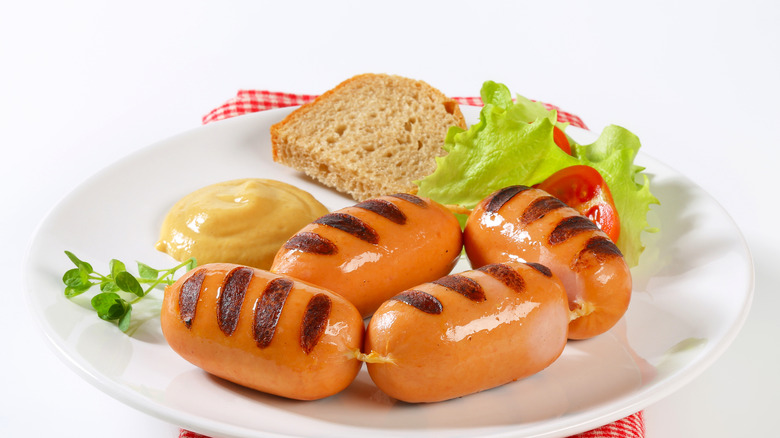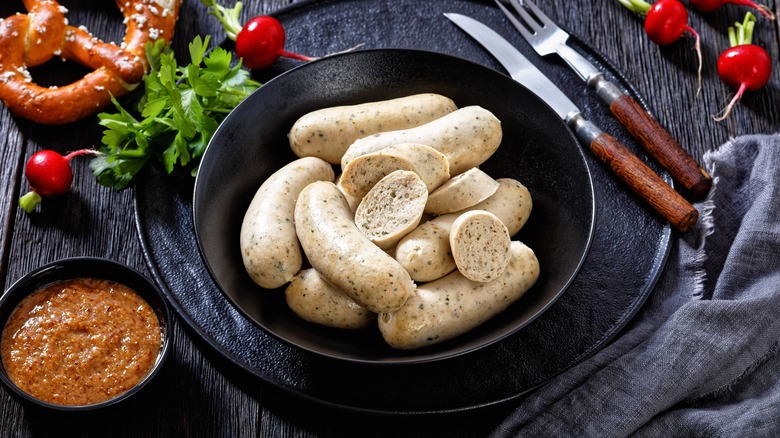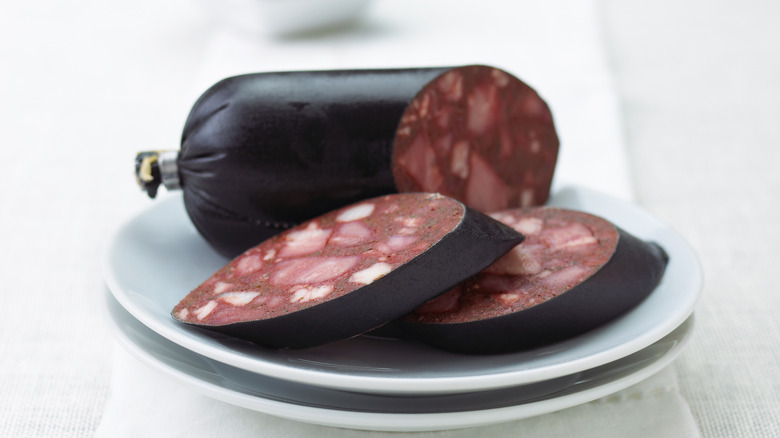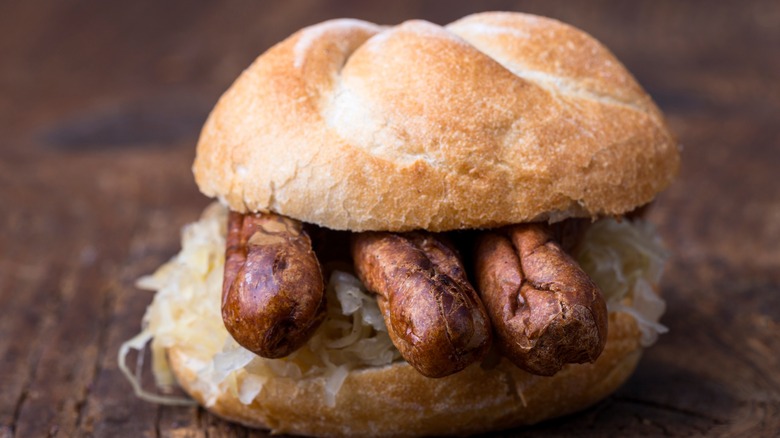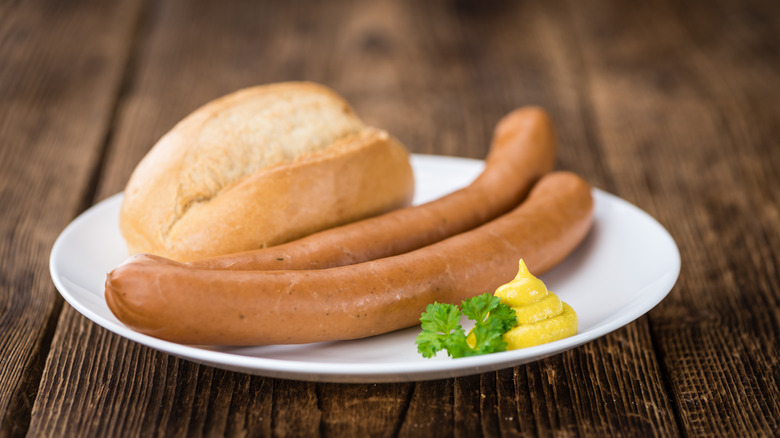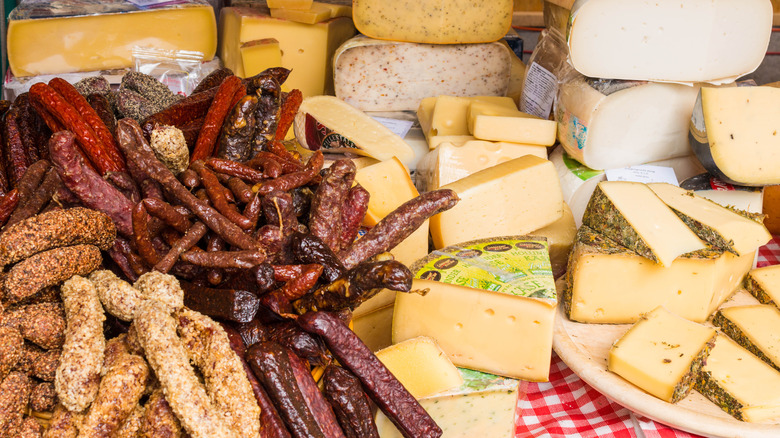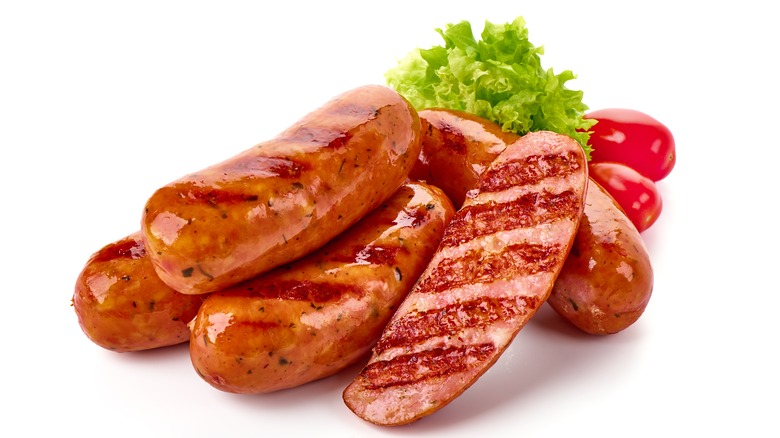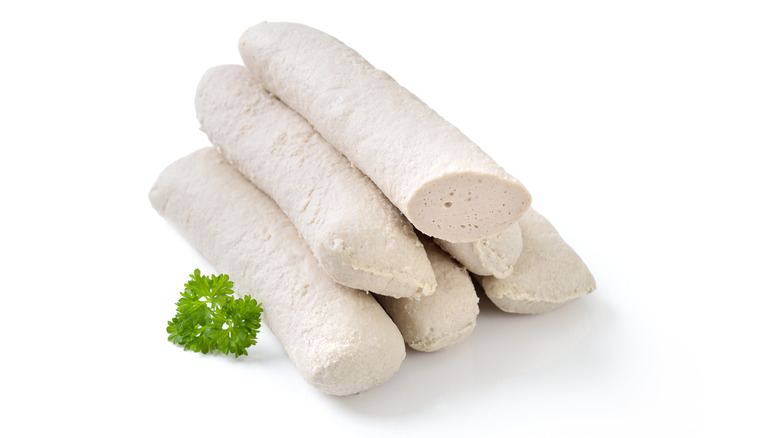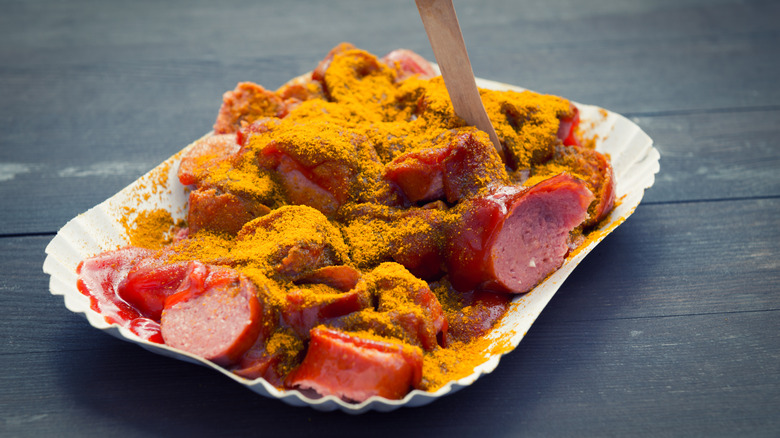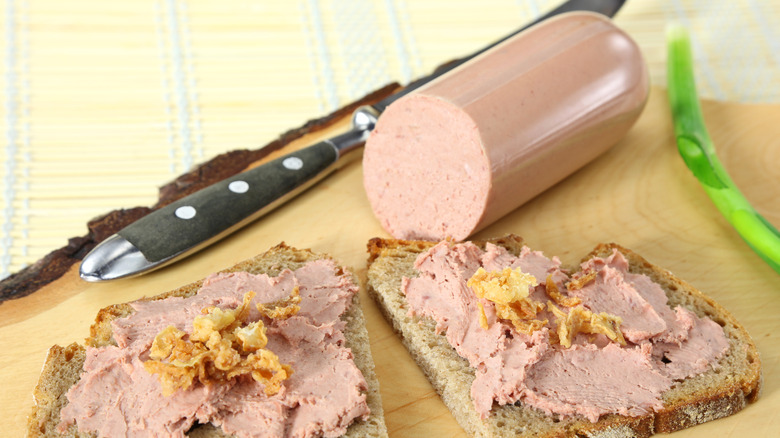10 German Sausages To Know And Love This Oktoberfest
Most of us think of Oktoberfest as the ultimate fall festival for grownups, a place and time where good beer flows freely alongside oompah bands and of course, lots of hearty food, including sausages. All of this is true. The event was first held in 1810 as a celebration of the wedding of the crown prince of Bavaria. It consisted of a five-day festival culminating in a horse race and was so popular among locals that they turned it into an annual celebration, which over time evolved to include amusement parks, dancing, food stalls, music, and more. Today, the annual, two-week festival attracts thousands of people to Munich, and over 2 million gallons of beer are consumed every year.
No matter how much you enjoy beer, you'll need some food to soak it all up. And, no food better serves this purpose than Germany's many traditional sausages. Ranging in flavor and texture from delicate and subtle to rustic and hearty, they'll not only keep you filled (and keep all that alcohol from shooting straight into your brain), but if chosen correctly, they will complement the flavor of whatever beer you're drinking. Here are some of the key varieties to look out for.
Knackwurst
To experience what guests enjoyed at the very first Oktoberfest in 1810, you need to try knackwurst. This short, fat, garlicky sausage, a traditional specialty of the northern German region of Holstein, originated in the 16th century as a rare treat reserved for royals. Because the first Oktoberfest was a royal wedding celebration for Crown Prince Ludwig, knackwurst took the place of honor as the main dish. At that event, it was served in a stew of potatoes and apples flavored with caraway seeds.
Over time, knackwurst (known as knockwurst in German-American communities) became increasingly accessible and is now a standard German supermarket product as well as an Oktoberfest staple. It's not as well known in the U.S. as more common sausage varieties such as bratwurst, but it's worth seeking out. Expect the short, fat sausages (typically made of veal and pork) to have a darker red color than a hot dog and a distinctly snappy skin. They're great grilled or smoked and can be tucked into a hot dog bun or other roll to make a hearty sandwich.
Weisswurst
Made with pork and veal, weisswurst is a smooth, delicately flavored Oktoberfest favorite and a local specialty in Munich, where a distinctive set of rules have evolved around serving and eating it. Some of these customs are based on how the weisswurst is made: Legend states that it was invented by accident when a sausage-maker ran out his usual sheep's casings and improvised using tougher pork casings. This worked but resulted in sausages with tougher skins and a tendency to burst when grilled. Thus, by custom, weisswurst is cooked in hot (never boiling) water rather than over direct heat and is often served in a container of hot water (which is not to be consumed) to ensure it arrives at the table hot.
In addition, the skin of weisswurst is never eaten. Instead, if you're eating weisswurst with a fork and knife, you should peel the skin off each bite before you eat it. But in Munich (and only in Munich), it's considered acceptable to eat weisswurst with your hands, squeezing it out of its skin as you go as if it were an ice pop in a plastic casing. Another important custom is to never eat weisswurst after noon. Historically, this was because in the days before refrigeration, the delicate meat would spoil by afternoon. Even today, weisswurst fans hold tight to this tradition. Breakfast food or not, however, weisswurst is traditionally enjoyed with beer — specifically, a weissbeer — along with pretzels and sweet mustard.
Blutwurst
One of the oldest sausage varieties, blutwurst, or blood sausage, is exactly what it sounds like: a sausage made largely of cooked blood along with ground meat and fat, grains such as wheat and barley, and generous amounts of spice. Originally a survival food, it was developed by frugal cooks as a way of making the most of scarce ingredients. But, its richly spiced, meaty flavor (somewhat reminiscent of liver) eventually made it a popular festival food.
Blutwurst differs from other European varieties of blood sausage (such as English blood pudding) in that it's often served cold and sliced, rather than hot. The blood lends this sausage a soft, melting texture, so don't expect the snap and bounce of a hot dog or bratwurst. The dark red, almost black, sausage not only makes a flavorful addition to a charcuterie board but is a filling meal when sliced and served atop a bed of french fries. Another traditional way to enjoy it that also tames its intense flavors is to serve it with cooked cabbage, mashed potatoes, and applesauce.
Drei im weggla
It's often said that good things come in threes, and this may be a reason why drei im weggla (literally "three in a bun") is such a beloved snack in Germany. This treat is, quite simply, three slender, grilled Nuremburg bratwursts tucked into a bun and traditionally served with mustard (and sometimes, sauerkraut). This makes drei im weggla an optimal choice if you don't want to miss everything Oktoberfest has to offer, since it lets you eat and explore at the same time.
Critically, however, you can't just plunk any three random sausages in a bun and call it drei im weggla. For an authentic drei im weggla, only real Nuremberg bratwurst will do. Legally, sausages must conform to a number of strict requirements to qualify as Nuremberg bratwurst. For one, just as real Champagne must be made in the Champagne region of France and authentic prosciutto di Parma must be made in Parma, Italy, Nuremberg bratwurst must be made in Nuremberg. Each sausage must be between 7 and 9 centimeters long and weigh no more than 25 grams. This means the three sausages in your portable meal will be slender enough to fit snugly in a bun without falling out but will be hearty enough to offer a generous mouthful of flavor with each bite.
Bockwurst
The German word bockwurst translates literally as "goat sausage," but in reality, the sausage rarely, if ever, contains goat (it's typically made from veal and pork). Instead, it got its name because it's commonly served with bock beer, a dark, sweet, lightly hopped lager. But, how the sausage and the beer came to be associated with each other is a matter of debate.
One popular legend says the sausage was invented in Berlin in 1889 when the owner of a tavern famed for its bock commissioned a local butcher to make sausage for a celebration he was hosting for students and faculty of a nearby university. Attendees at the celebration reportedly loved the sausage and dubbed it bockwurst. However, print advertisements and other documents dating back to the 1870s also mention bockwurst and bock beer, suggesting that a different sausage with the same name had already emerged by the time of the Berlin celebration. To make things even more confusing, the bockwurst enjoyed by German-American communities is a white sausage flavored with vegetables including leeks and celery, while the bockwurst found in Germany is an emulsified, hot-smoked, pork-and-bacon sausage with a pink interior. The bockwurst that arrives when you place an order will vary depending on where you're celebrating Oktoberfest.
Landjäger
A regional specialty popular in southern Germany, Austria, Switzerland, and the Alsace region of France, landjäger is a smoked, semi-dried sausage made of equal proportions of beef and pork and flavored with red wine, sugar, and spices. The meat mixture is pressed into rectangular molds before smoking, giving the sausages a characteristic, square-edged look.
Because landjäger comes in single serving–sized pieces, can stay fresh without refrigeration, and can be eaten without further cooking, it was historically popular as a food for soldiers, who could easily carry it with them and eat it on the go. For the same reasons, it has also become a popular snack choice for hikers and campers today. But, the flavorful sausage also makes a respectable sit-down meal — it can be boiled and served with potatoes and vegetables or served cold with bread and potato salad. Its odd name has a convoluted history. While the word landjäger is an archaic German term for a type of mounted patrol officer, the name of the sausage is thought to have originated from an unrelated Swiss-German dialect term for "long smoked." German speakers elsewhere misheard this as the term for a patrol officer, and Alsatian French speakers did so, as well, dubbing the sausage gendarme, French for "police officer." This bit of mistaken folk etymology continues to stick to this day.
Thüringer
Thüringer is another traditional German sausage that morphed into something completely different upon its arrival in the United States. If you're lucky enough to go to Germany for Oktoberfest, the sausage you'll get is Thüringer bratwurst, a sausage with geographically protected status that's proudly distinct from other varieties of bratwurst. By regulation, it contains only 25% fat (in contrast to the 60% common in other varieties) and is flavored with a mixture of marjoram, garlic, and lemon. Some versions include additional spices such as caraway and nutmeg. By tradition, this fresh sausage is meant to be cooked and eaten the day that it's made.
Ask for thüringer at an Oktoberfest celebration in the U.S., however, and chances are you'll get something completely different — a smoked, semi-dry sausage similar in texture to a summer sausage. Popular in German communities in the Midwest (though harder to find elsewhere), American-style thüringer is made with a mixture of beef and pork and has a tangier taste than typical summer sausage due to its longer fermentation time. It's also more aggressively spiced, often containing ingredients such as whole mustard seeds. It makes a hearty snack when sliced and eaten with crackers, and even works well as a pizza topping.
Wollwurst
A rustic close relative of weisswurst, wollwurst (which translates as "wool sausage") is a traditional, but now uncommon, specialty of Bavaria. Like weisswurst, it's a white sausage that's said to have been invented by accident. One legend states that a butcher forgot to order sausage casings but went ahead and made sausages anyways, piping the raw sausage mixture straight into the cooking pot. The resulting skinless sausages tasted fine but had a rough exterior texture that, combined with the naturally pale meat, resembled uncarded wool, hence the name of the sausage.
Wollwurst, like weisswurst, contains a mixture of pureed pork and veal. It's lightly spiced with white pepper, lemon peel, mace, and cardamom. Like weisswurst, it's gently poached, rather than boiled. Because they're skinless, they tend to bloat a bit as they cook, earning them another German nickname: g'schwollne, or "swollen ones." Wollwurst are traditionally dipped in milk and pan-fried until brown before serving, then served with gravy and Bavarian-style potato salad dressed with oil and vinegar.
Currywurst
While not a traditional Oktoberfest food — or a regional specialty of Munich — currywurst has become such an important part of modern German food culture that no trip to Germany, or survey of the country's sausages and sausage-eating culture, would be complete without it. It was invented in Berlin after World War II by a local resident, Herta Heuwer, who'd acquired some ketchup from British soldiers in a trade and devised a quick dish of sliced sausages topped with ketchup and curry powder. This inexpensive and novel creation instantly became popular with the hungry construction workers rebuilding Berlin and soon became a favorite late-night street food for Berliners from all walks of life.
Today, currywurst is celebrated as late-night comfort food to enjoy after a long night of drinking, which makes it especially appropriate for Oktoberfest. There are no firm rules about what kind of sausage goes in currywurst (after all, it was a dish invented for convenience, not to showcase fancy regional ingredients), but bratwurst, knackwurst, or even plain hot dogs all make good partners for the sweet-spicy sauce.
Leberwurst
Leberwurst, or liverwurst, is an old-school German sausage that some people love and some people hate, as pork and beef liver are its dominant ingredients. If you like liver, you'll enjoy it, but if you don't, you won't. For liver fans, there are several variants of the sausage to choose from. Standard leberwurst is a smooth, spreadable sausage of pureed liver seasoned with salt, black and white pepper, allspice, coriander, mustard seed, and marjoram. The ingredients are ground together, stuffed into casings, and cooked. Another type of German liver sausage is Pfälzer liverwurst, a coarser sausage that contains lean pork and pork belly along with pork liver. Instead of being ground, then cooked, the meats are cooked before they're roughly ground and stuffed into casings (or canning jars).
Closely related to regular liverwurst is braunschweiger, a liver sausage that originated in the city of Braunschweig. Like regular liverwurst, it's made from spiced, finely ground pork or beef liver that's stuffed into casings before cooking. Unlike regular liverwurst, braunschweiger can be smoked and sometimes contains smoked meats such as bacon. All of these soft, rich sausages make great sandwich fillings.


